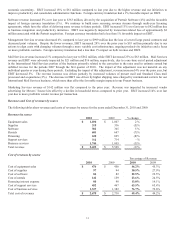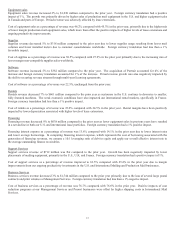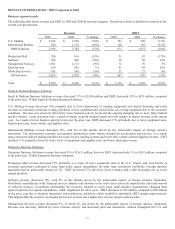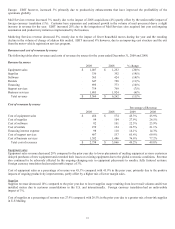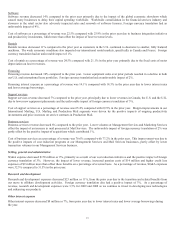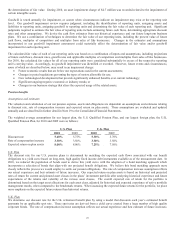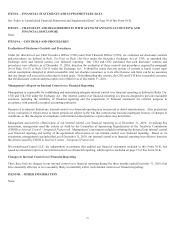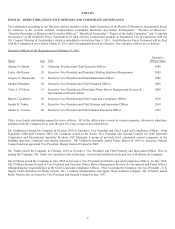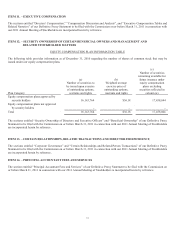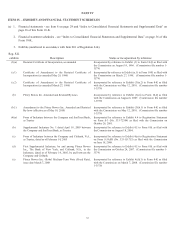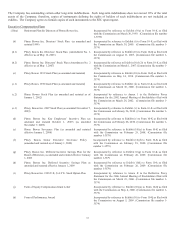Pitney Bowes 2010 Annual Report Download - page 43
Download and view the complete annual report
Please find page 43 of the 2010 Pitney Bowes annual report below. You can navigate through the pages in the report by either clicking on the pages listed below, or by using the keyword search tool below to find specific information within the annual report.24
prevailing economic conditions, and make adjustments to our actual aggregate reserve as necessary. This evaluation is inherently
subjective and actual results may differ significantly from estimated reserves.
Allowance for credit losses
We estimate our finance receivables risks and provide allowances for credit losses accordingly. We establish credit approval limits
based on the credit quality of the customer and the type of equipment financed. Finance receivables are written-off against the
allowance for credit losses after collection efforts are exhausted and we deem the account uncollectible. We believe that our
concentration of credit risk for finance receivables is limited because of our large number of customers, small account balances and
customer geographic and industry diversification. Our general policy is to discontinue revenue recognition for lease receivables when
they are delinquent more than 120 days, and to discontinue revenue recognition on unsecured loan receivables that are delinquent for
more than 90 days. We resume revenue recognition when payments reduce the account to 60 days or less past due.
We evaluate the adequacy of allowance for credit losses based on our historical loss experience, the nature and volume of our
portfolios, adverse situations that may affect a customer’s ability to pay and prevailing economic conditions, and make adjustments to
our actual aggregate reserve as necessary. This evaluation is inherently subjective and actual results may differ significantly from
estimated reserves.
Accounting for income taxes
We are subject to income taxes in the U.S. and numerous foreign jurisdictions. Our annual tax rate is based on our income, statutory
tax rates and tax planning opportunities available to us in the various jurisdictions in which we operate. Significant judgment is
required in determining our annual tax rate and in evaluating our tax positions.
We regularly assess the likelihood of tax adjustments in each of the tax jurisdictions in which we operate and account for the related
financial statement implications. We establish reserves when, despite our belief that our tax return positions are fully supportable, we
believe that certain positions are subject to challenge and possible adjustment. We adjust these reserves, as well as the related interest,
in light of changing facts and circumstances, such as the progress of a tax audit. We have established tax reserves which we believe to
be appropriate given the possibility of tax adjustments. Determining the appropriate level of tax reserves requires us to exercise
judgment regarding the uncertain application of tax law. Future changes in tax reserve requirements could have a material impact on
our results of operations.
Significant judgment is also required in determining any valuation allowance recorded against deferred tax assets. In assessing the
need for a valuation allowance, we consider all available evidence for each jurisdiction including past operating results, estimates of
future taxable income and the feasibility of ongoing tax planning strategies. As new information becomes available that would alter
our determination as to the amount of deferred tax assets that will ultimately be realized, we adjust the valuation allowance with a
corresponding impact to income tax expense in the period in which such determination is made.
Based on our 2010 income from continuing operations before income taxes, a 1% change in our effective tax rate would impact
income from continuing operations by approximately $5 million.
Goodwill and long-lived assets
Useful lives of long-lived assets
We depreciate property, plant and equipment and rental property and equipment principally using the straight-line method over the
estimated useful lives of three to 15 years for machinery and equipment and up to 50 years for buildings. We amortize properties
leased under capital leases on a straight-line basis over the primary lease term. We amortize capitalized costs related to internally
developed software using the straight-line method over the estimated useful life, which is principally three to ten years. Intangible
assets with finite lives are amortized over their estimated useful lives, which are principally four to 15 years, using the straight-line
method or an accelerated attrition method. Our estimates of useful lives could be affected by changes in regulatory provisions,
technology or business plans.
Impairment review
We evaluate the recoverability and, if necessary, the fair value of our long-lived assets, including intangible assets, on an annual basis
or as circumstances warrant. We derive the cash flow estimates that are incorporated into the analysis from our historical experience
and our future long-term business plans and, if necessary, apply an appropriate discount rate to assist in the determination of its fair
value. In addition, we used quoted market prices when available and appraisals as appropriate to assist in the determination of fair
value. Changes in the estimates and assumptions incorporated in our long-lived asset impairment assessment could materially affect


